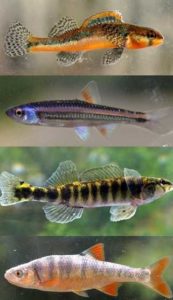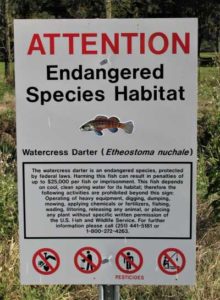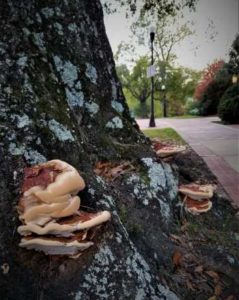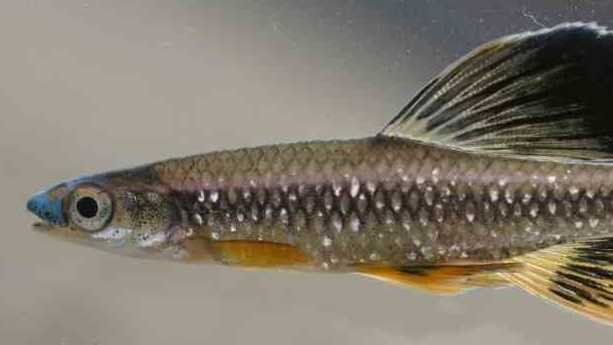Alabama has leveled up in state biodiversity rankings!
Nearly twenty years ago, Dr. Bruce Stein, chief scientist for the National Wildlife Federation released a study that forever redefined Alabama. The 2002 report, “States of the Union: Ranking America’s Biodiversity,” compared US states for their total number of species. Stein’s team found that Alabama ranked first in the eastern US for the number of native species, and fifth in the whole country.
The report changed my life. It came out just as I began teaching at Birmingham-Southern College. I started using Alabama’s ranking to initiate conversations about biodiversity in the classroom and during public lectures. People were excited to learn about the state’s latest claim to fame.
Reactions were so positive that several years later I wrote Southern Wonder: Alabama’s Surprising Biodiversity. In the book I take readers on a journey across the state to discover why the Alabama has so many species.
When States of the Union was published, Alabama was merely 50 species behind fourth-ranked New Mexico. Because scientists discover new species in Alabama each year, other biologists and I predicted that the state would eventually rise to fourth place, possibly higher.
As we approach the 20th anniversary of Stein’s report, I decided to track down current data on how Alabama ranks against other states. I was ready for days of sleuthing through databases and research reports, but was relieved to find the recently updated NatureServe Explorer. It had everything I needed.
NatureServe, the same group that published States of the Union, is a science-based non-profit dedicated to compiling biodiversity data and sharing it with decision makers. The Explorer is an online database open to everyone. It allows filtering by geographic area, conservation status (e.g., endangered), and taxonomic group (e.g., fishes, reptiles). Though the Explorer is easy to use, pulling meaningful information from any massive database requires forethought. Here’s why…
Our science on biodiversity is incomplete. We don’t know precisely how many species are on earth, nor in any US state. Knowledge is especially lacking for difficult-to-study taxa (groups of related organisms) that are small and hard-to-find. Biologists call such organisms cryptic species. Experts on cryptic taxa frequently discover new species (e.g., new cave pseudoscorpions in Alabama). State lists for cryptic taxa are woefully incomplete.
In contrast, large and/or charismatic taxa like mammals and butterflies are well-studied, and new discoveries are rare (e.g., a new 2-foot-long salamander was discovered in Florida and Alabama in 2018).
For these reasons, when Bruce Stein and his team compared states, they only included taxa for which scientists had relatively complete data. It was a way to standardize the comparison.
As I worked on updating the rankings, I set the filters to only include the taxa that Stein had included in the 2002 analysis: vascular plants, vertebrate animals, and invertebrates such as freshwater mollusks and dragonflies. I ran the search for the top twelve states from the 2002 report.
I was elated with what I found—Alabama had gained 204 species and now ranks fourth among all US states. Furthermore, Alabama is just 84 species behind third-ranked Arizona. Go Alabama!
I wanted to get some perspective on this news from someone who knows a lot about Alabama’s role as a biodiversity hotspot. So, I reached out to Mitch Reid, the executive Director of the Alabama Chapter of the Nature Conservancy (TNC). TNC is a non-profit organization whose mission is to preserve biodiversity for its own sake, and for everyone who depends on it (that would include all of us, by the way).
“I am thrilled to see Alabama’s world class biodiversity recognized and I am not surprised at all to learn that Alabama has moved up in the list. We are discovering more and more species all the time and I think that with time we may move even higher.”
Reid highlighted a major reason why Alabama has so many species. “So much of our biodiversity is due to our amazing freshwater systems. That is why Alabama is ranked number one in freshwater biodiversity.”
So true. As readers of Southern Wonder learn, the state’s dramatic geologic history created a terrain divided into large watersheds, each harboring a unique suite of freshwater species.
But Reid also pointed to the darker side of Alabama’s biodiversity. “Unfortunately, Alabama is also near the top of the list of for threatened and endangered species.”

In 2002 Alabama ranked second for total number of extinctions—species we’ve completely eradicated from earth. Today the extinction crisis is still raging—Alabama currently ranks third among states for total imperiled species. The great majority of Alabama’s 143 endangered species are freshwater animals, especially mussels, snails, and fishes.
The loss of freshwater species is a global problem due to the sad condition of the world’s rivers. A report published days ago (Feb 2021), The World’s Forgotten Fishes, highlighted the desperate condition of the world’s freshwater fishes. A third of species are imperiled, and 80 species are extinct.
The future of southeastern US rivers—including the region’s unique river fishes—is the subject of my forthcoming book, provisionally entitled Creeks to Coast: Restoring the Rivers at the Heart of America’s Freshwater Biodiversity.
This isn’t just a fish problem—it’s a people problem, too. The Forgotten Fishes report finds that freshwater fishes provide protein to 200 million people and provide jobs for 60 million. And just in the US, recreational fishing accounts for $100 billion per year. That’s not a typo, that’s billion with a B!
Extinction is a global problem with local solutions. With 17 freshwater fishes on the US endangered species list, Alabama must do its part to stop the bleeding.
Fortunately, scientists and conservationists across the Southeast are working to save fishes.
Reid said that the high rate of species endangerment “has driven a significant amount of federal funding to Alabama aimed at protecting these species.”

Unfortunately, not everyone is on-board. Reid explained that the State of Alabama doesn’t invest in conservation at levels proportional to our national rankings. This is nothing new. Alabama has a long track-record of not investing as much as other states in protecting its environment—even when those safeguards would save human lives, too.
Mitch Reid and I wish state leadership understood that species conservation is a cost-effective strategy to ensure that Alabamians have a secure and prosperous future. Alabama’s ecosystems provide clean air and water, buffer us from extreme climate events, and offer us beauty and recreation. The benefits are economic, cultural, and psychological. And all of this depends on the state’s native species. Without them, ecosystems crumble.
***
Before I surfaced from my data dive into the NatureServe database, I peaked at where Alabama ranked when tallying all taxa, not just those well-studied by scientists. Though Alabama has received far less attention from scientists than other top-ranked states, Alabama landed in fifth place.
As before, the leaders were California and Texas, respectively. Not a surprise given their size and geographic diversity. But the big upset was North Carolina and Oregon. They rose to third and fourth position, from eighth and ninth place, respectively.
State rankings are more of an indication of research effort than true geographic patterns of biodiversity.
For example, Oregon reports 443 fungi species, while Alabama lists only 8. Anyone who walks an Alabama trail after a rainy week in summer can spot over a dozen species of mushrooms and other fungi.
Or consider moths. North Carolina reports 306 species, and Alabama only 66. My colleague at Birmingham-Southern College, Dr. Pete Van Zandt, has 600-700 Alabama moth species in his teaching collection. And a colleague of his in Georgia has a collection of 2500-3000 moth species. There’s every reason to expect that Alabama has at least as many moth species as Georgia.

Were Alabama’s moths and fungi fully documented and reported to NatureServe, the state would be in second place for total known species. Imagine that!
This interstate rivalry over these rankings is fun, and helps draw attention to biodiversity research and conservation. But in the big picture, every species everywhere plays a role in maintaining the natural habitats that sustain our economy, health, and culture. That’s as true in a state like Alabama as it is in states with far fewer species.
And this underscores my final point. If we want to protect the ecosystems that help us survive and thrive, we must know what species are out there, and what they are doing. We can’t protect what we don’t know exists.
As for the importance of funding biodiversity research, TNC’s Mitch Reid had these final thoughts to share. “Hopefully … our state government will invest more to restore and protect this [Alabama’s] natural wonderland. I envision a day when Alabama is THE destination for scientists from all over the world traveling here for field research. It’s that big of a deal.”
how to help:
You can help biodiversity by maintaining natural habitats in your yard, or volunteer to do the same in your local park. Fewer lawnmowers and more native species please!
If you are able, consider funding statewide efforts to study and protect biodiversity in Alabama.
- Donate to the Alabama Natural Heritage Program, the group out of Auburn University that helps catalog and monitor Alabama’s species. ANHP is the source for NatureServe’s database.
- Buy an Alabama hunting or fishing license. A portion of the revenue funds the state’s nongame wildlife program. You can still buy a license if you don’t hunt or fish, or you live out of state.
- Support the work of the Alabama Wildlife Federation, an organization that funds conservation programs. Purchase an Alabama Wildlife Heritage License or an Alabama Wildlife Federation plate next time you renew your vehicle’s license plate.
- Donate to the Nature Conservancy of Alabama and their efforts to protect and restore biodiversity and ecosystem throughout Alabama.
- Donate to NatureServe and support their efforts to inventory and share data about biodiversity in Alabama and across the US.
Learn more:
- Extinct mussels of the American Southeast. A poster by Todd Amacker and Chris A. Johns from the Center for Biological Diversity. Information about mussel biology and the history of extinction.


Great article! What is the colorful fish at the top of the article?
Thank you!
That is a Bluenose Shiner, Pteronotropsis welaka. The photo was taken by Dr. Bernie Kuhajda, the Science Program Manager at the Tennessee Aquarium Conservation Institute. Bernie is one one of the top ichthyologists in the region.
Hi Scot!
Thank you for the update. I think we in Alabama are behind in data updating/documenting. As it pointed in the article “State rankings are more of an indication of research effort than true geographic patterns of biodiversity.” What does it means that ” Oregon reports 443 fungi species, while Alabama lists only 8″ ? Who is Alabama here? Just records supplied by Alabama Natural Heritage Program?
Many scientists works by documenting and helping in identification for other enthusiasts in iNaturalist.org . But looks like that was not counted. I believe many people have found more species than I do, but I already posted 667 species of Fungi including lichens for Alabama. Also, near 200 species of moths (where I am not big enthusiast), 250 species of Cicadas and other Hoppers (Auchenorryncha) and so on. Are all plants from Alabama Plant Atlas and all butterflies from Alabama Butterfly Atlas are included? “…at Birmingham-Southern College, Dr. Pete Van Zandt, has 600-700 Alabama moth species in his teaching collection” – why that is not included? If our status in “States of The Union” is important – we have plenty species already documented but not included and plenty more to find! Of course for me good enough to know these species survived even not documented :)
Appreciate you, your work, and your publications!
Hi Vitaly! These are great points you bring up. When I say that Alabama only reports 8 species, that is how many species are present in the NatureServe Explorer database. And as I understand it, those records are submitted by Alabama Natural Heritage Program (ANHP). However, through the hard work of you and others, the number of species documented within Alabama is much higher than what’s in the NatureServe Explorer database. I need to reach out to my friends at ANHP and ask what it would take to upload data on new species occurrences in Alabama. How cool would it be for us to “level up” again and surpass Arizona, and possibly Texas!
Great article, Scot – thanks for sharing! I’ve referred to it many times over the last few months. I am curious specifically about our floristic diversity ranking. Last I heard, we were 9th in the nation, but I believe that was also based on the 2002 report. Have you seen any changes there? It’s hard to imagine with all the work in recent years by folks like Drs. Brian Keener and Larry Davenport that we haven’t leveled up there as well.
Thank you. When I ran the numbers in March of this year (2021) Alabama was still at ninth position for vascular plant diversity. But consider this… These stats that we use to compare states are from the NatureServe database. NatureServe gets its data from Alabama from the Alabama Natural Heritage Program (ANHP). ANHP has a small staff and they may not have been keeping up with discoveries of new plants in the state. For example, after I published this post, I found that dozens of birds that have been sighted in Alabama are not on the list. I’m currently working with one of the ANHP staff members and one of the state’s ornithologists to get the new sightings into the database. It’s a complicated process but I am hoping that we can find a way to make adding new species to the database easier for ANHP and for citizens to contribute to the process. There’s more to the story, and I’d be happy to talk with you about it–just email me.
A little late, but just came across your post about the 20 year update to my States of the Union report. Delighted to see how that report’s highlighting of Alabama’s extraordinary biodiversity has helped inspire your work!
Thank you, Bruce! The States of the Union report was groundbreaking for conservation in Alabama, and I am sure for many other places. Much Gratitude!!